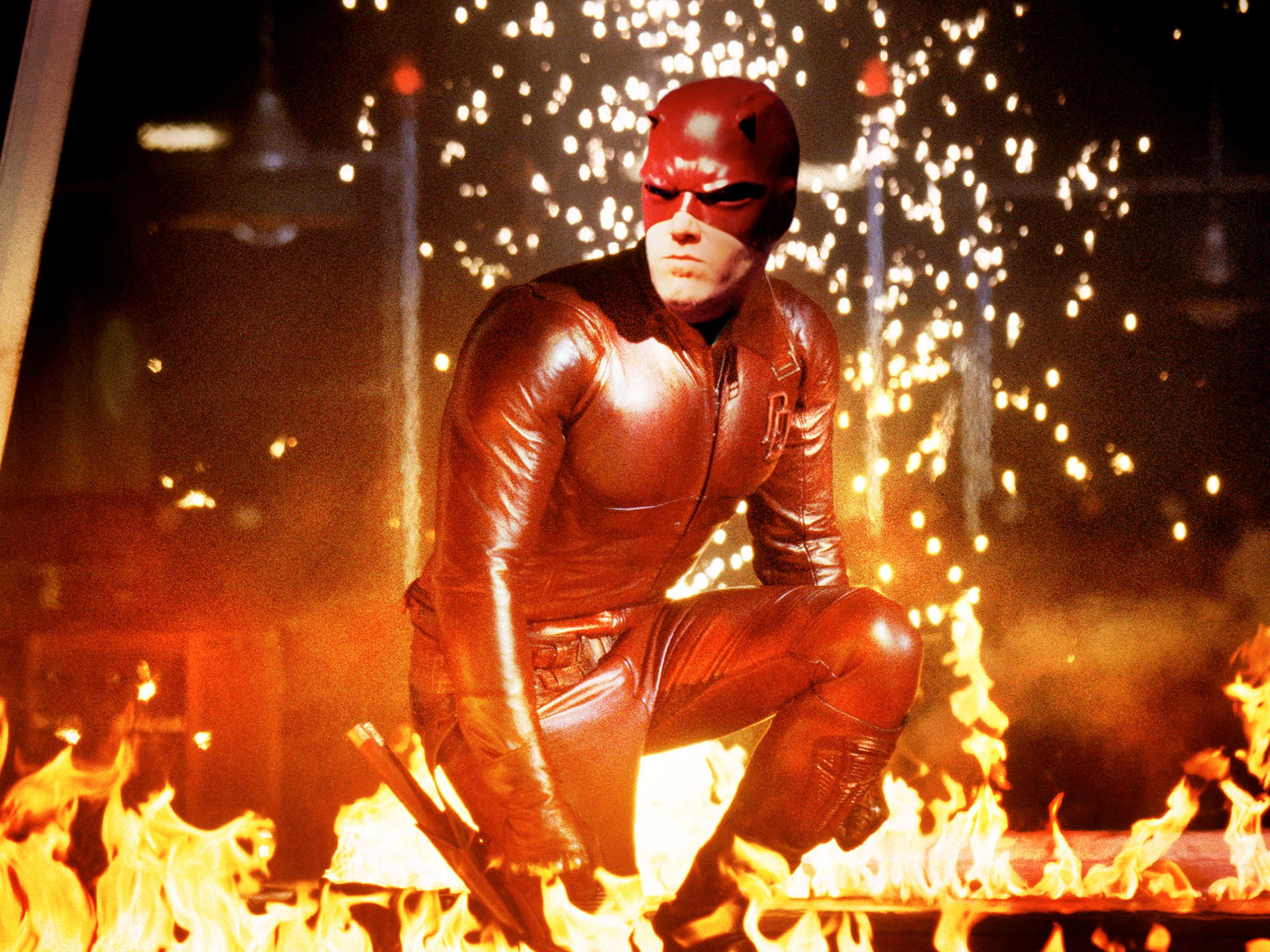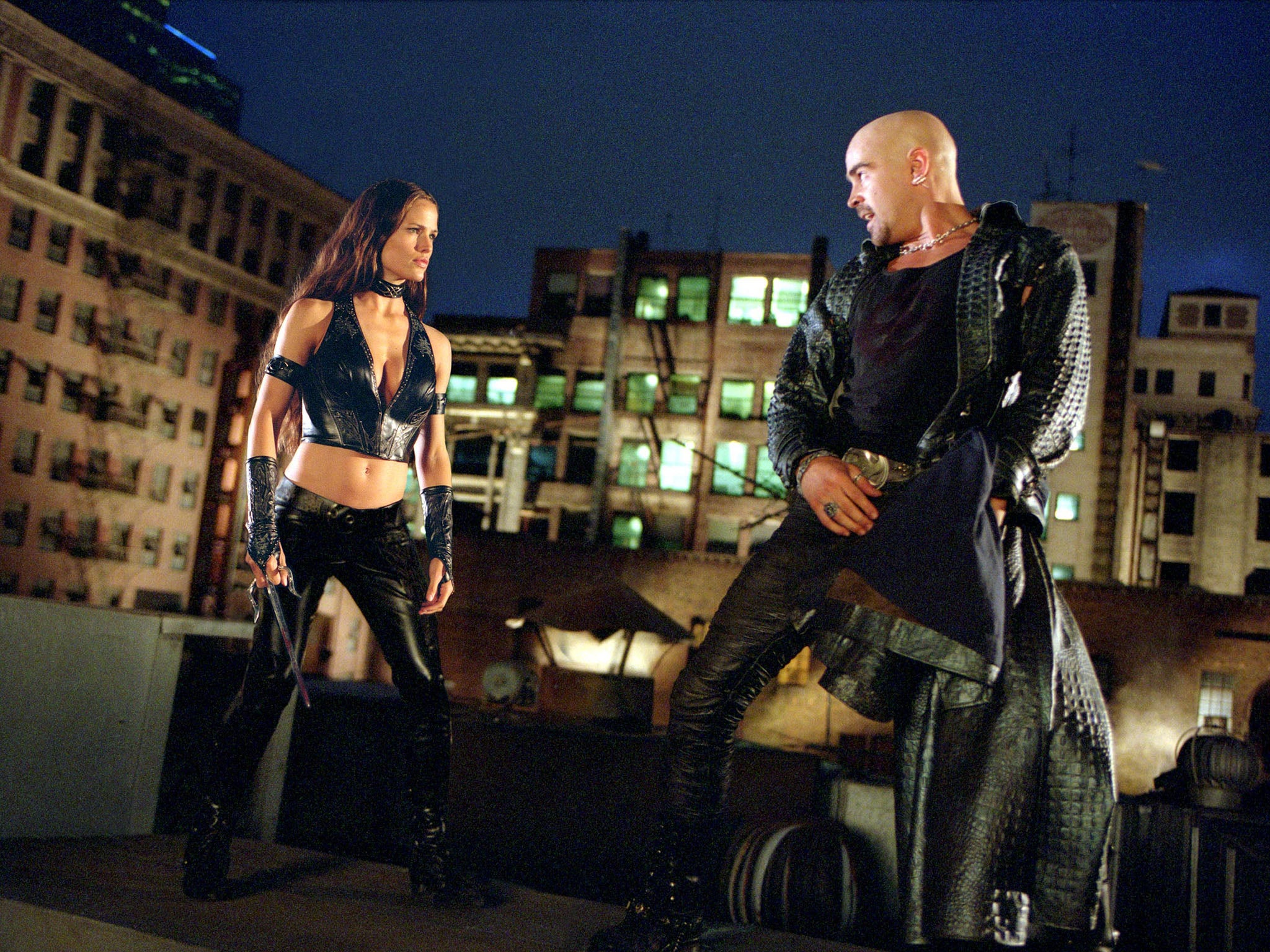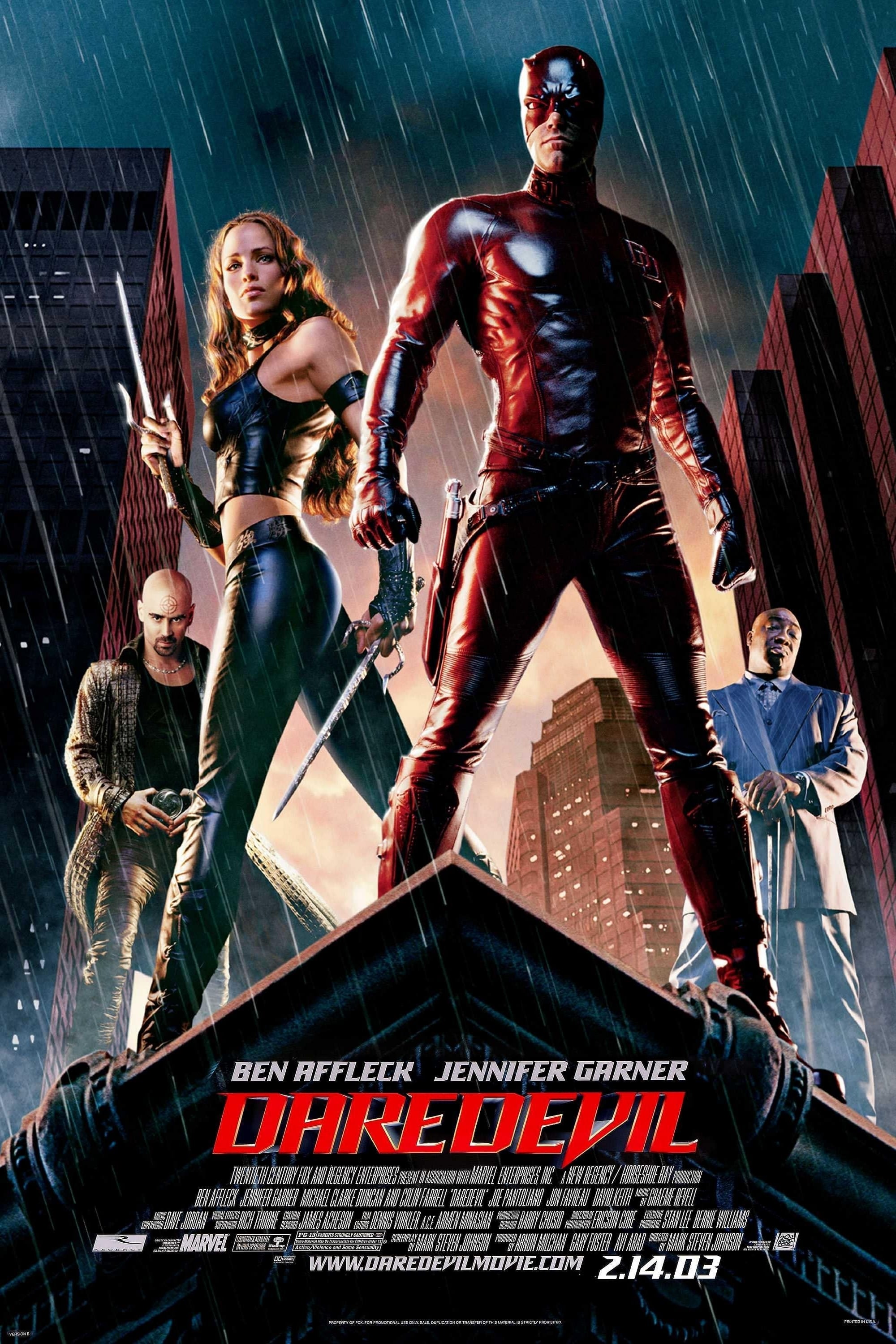Daredevil at 20: Backlash, Evanescence and Ben Affleck’s (first) superhero flop
Nothing screams 2003 more than a ‘Gigli’-era Ben Affleck in tight red leather and a training montage set to Hoobastank. As the divisive ‘Daredevil’ marks its 20th anniversary, Tom Fordy salutes an occasionally hilarious Marvel misfire

Ben Affleck only regrets one movie: Daredevil. That’s what the actor once told Playboy about the 2003 superhero misstep. “It just kills me,” said Affleck. “I love that story, that character, and the fact that it got f***ed up the way it did stays with me.” Released on 14 February 2003, Daredevil was an attempt at a darker, grittier superhero film – gritty in a pre-Nolan sort of way, at least. It tells the story of blind lawyer Matt Murdock, who avenges his murdered father (that old chestnut) by cleaning up the grubby streets of Hell’s Kitchen. Blinded as a child by toxic goop, Murdock has enhanced senses as an adultre, which manifest as a kind of super-powered radar. Twenty years on from its release, Daredevil looks like a proto-franchise player – an attempt to get a Marvel movie series off the ground before filmmakers had quite figured out the formula. It leaves it an unwieldy if occasionally interesting relic.
Daredevil’s divisive reputation is neatly summed up by its most offending article: Affleck’s fanboy-riling leather suit, which was very much not the spandex version of the source material. Even Charlie Cox, who has played Daredevil since 2015 in both an eponymous Netflix series and the MCU – most recently cameoing in Spider-Man: No Way Home – once commented that “the suit sucks”. What fans didn’t know was that writer-director Mark Steven Johnson had to fight with the studio for any costume. For Johnson – a diehard Daredevil fan – production was “a non-stop battle.” The executives wanted to replicate the success of Sam Raimi’s Spider-Man – released a year earlier – but didn’t understand the Daredevil character. “They didn’t want a costume,” he later said. “They didn’t want horns. They didn’t want anything.”
Like other superhero films, Daredevil was in the works for several years before Affleck finally suited up. Marvel was in financial peril in the 1990s and hadn’t yet started to produce its own films. Film adaptations of their biggest characters stalled. Twentieth Century Fox nabbed the rights to the X-Men in 1993, though the film didn’t reach cinemas until 2000. Sony picked up Spider-Man after a years-long web of complicated rights wrangling. The eventual films, however, were super-sized hits. The Los Angeles Times wrote that “franchise fever” had seized Hollywood.
Twentieth Century Fox had optioned Daredevil in 1997, with Chris Columbus (of Home Alone and Harry Potter fame) in line to direct. When that didn’t work out, Disney flirted with buying the rights but soon dropped out of contention (amusing, considering that Disney now owns Marvel and, subsequently, the rights to Daredevil). The character went to Sony, then New Regency – with Twentieth Century Fox distributing. Johnson, who’d first been hired to write the script at Sony, had to pitch to get back onboard the project. Studio executives were unsure if he was the man for the job. Johnson had written the Grumpy Old Men movies and, at the time, had just one directing credit to his name – the quiet 1998 comedy-drama, Simon Birch.
Kuljit Mithra, who launched the popular Daredevil fansite Man Without Fear back in 1996, tells me that Johnson contacted him at the time. “He said, ‘I’ve got some stuff I want to run by you’,” says Mithra. “Back then, it wasn’t like everybody was an insider! He emailed me storyboards. He sent me all this three years before it was even greenlit. He asked me how it looked.”
Back then, Daredevil was still a niche hero, despite being created by Stan Lee and Bill Everett in 1964, Marvel’s golden age for superhero creation. “I read the comics as a kid,” says Mithra. “As I got older, I noticed that Daredevil was in his own world – he didn’t cross over with a lot of other titles. But he seemed to attract the best writers and artists. They’d always ask to try Daredevil because he was not a high-prestige character. Marvel was like: “Does somebody want to work on this character? We’ll just print it.”
In the 1980s, Daredevil got a gritty reinvention with writer Frank Miller. Mark Steven Johnson drew mostly from Miller’s stories. If anything, says Mithra, the film may follow Frank Miller’s stories – which featured many of Daredevil’s closest allies and villains – a bit too closely. “I think he tried to fit as much as he could in one movie,” says Mithra. “He basically did the whole Frank Miller arc. If he had the space and time of the Netflix show, maybe he could have made it work.”
When I told people I ran a Daredevil website, they’d go, ‘What, about Ben Affleck?! Why?’
Before Affleck was cast, the role of Matt Murdock/Daredevil was offered to Vin Diesel, Guy Pearce and Affleck’s real-life BFF Matt Damon. Not everyone loved the idea of Affleck as Daredevil – he was also in the midst of a run of poorly received films, including Pearl Harbor and Gigli – but he was a fan of the comic and a close friend and collaborator of filmmaker and comic-book devotee Kevin Smith. Smith, following films such as Clerks, Mallrats, and Chasing Amy, had even written an acclaimed run of the Daredevil comic, and cameos in the film itself.”
Surrounding Affleck was Jennifer Garner as assassin and love interest Elektra; Colin Farrell as crack shot henchman Bullseye; Michael Clarke Duncan as Wilson Fisk aka Kingpin; and Jon Favreau as Murdock’s lummox lawyer sidekick, Foggy. Favreau later directed Iron Man, the 2008 film that kicked off the Marvel Cinematic Universe and rendered films like Daredevil almost obsolete – mere footnotes in superhero cinema.

Watch Apple TV+ free for 7 day
New subscribers only. £9.99/mo. after free trial. Plan auto-renews until cancelled.
ADVERTISEMENT. If you sign up to this service we will earn commission. This revenue helps to fund journalism across The Independent.

Watch Apple TV+ free for 7 day
New subscribers only. £9.99/mo. after free trial. Plan auto-renews until cancelled.
ADVERTISEMENT. If you sign up to this service we will earn commission. This revenue helps to fund journalism across The Independent.
Clarke Duncan, who died in 2012, was unsure at first about playing the oversized crime lord, Kingpin. “He’s cool,” he once said. “But he’s white.” These days, the casting might cause a meltdown in the most toxic corners of online fandom, but there was no doubt that Clarke Duncan – a 6ft 5in, 300lb powerhouse – was the right man for the job. “Mark Steven Johnson wanted someone who embodied strength,” says Mithra. “All the fan casting was ‘let’s have some gigantic wrestler play the Kingpin’, but you’ve got to have someone who can act.”
Elsewhere, Farrell seems to be having a blast as Bullseye, a petulant, gobby hitman with a target carved into his forehead and who kills people by any means necessary. He’s always mid-flick, whether with knives, paper clips or peanuts. “I want a bloody costume,” Bullseye says at one point, nodding to the fact that his (admittedly daft) costume had been lost in the transition from page to screen. Indeed, these were the days when producers didn’t want to see the proper costumes on their heroes and villains. Look at the Power Ranger-like Green Goblin in Spider-Man, or the leather-clad X-Men. “What would you prefer,” Cyclops asks Wolverine in 2000’s X-Men. “Yellow spandex?” There was a hint of embarrassment about it all. For Johnson – who understood comic book fandom – Daredevil’s costume represented a significant behind-the-scenes battle.

“It was ridiculous,” he said in 2019. “They were like, ‘We’re not going to put a man in devil horns! They call him Daredevil because he does daring things, not because he dresses up like a devil’. I was like, ‘You have to! Otherwise, he’s not Daredevil’.” Eventually, Fox executives conceded on the costume, but then fought Johnson on the colour red. The studio wanted black. They eventually compromised on something in the middle, more or less the colour of blood. Johnson added: “And then some people go, ‘Bah, he’s got a leather costume, that’s bulls***, he should be in spandex. You ruined my childhood’. And I’m like, ‘Dude, you have no idea – I fought so hard just to get horns’.”
Daredevil was initially seen as a modest actioner with a budget of $50m (£41m). The character didn’t have the brand name value to warrant a mega budget. (Producer Gary Foster recalled that whenever he told people he was making a Daredevil film, they thought he meant a biopic about the stunt motorcyclist, Evel Knievel.) But when Spider-Man was released in 2002 and grossed around $800m (£667m) at the global box office, Fox boosted Daredevil’s special effects budget. “They saw what Spider-Man had done at Sony and tried to replicate it,” says Mithra. “Because they really didn’t know Daredevil well. They tried to do the same marketing and promotion – even the soundtrack.”
While Spider-Man plumped for Nickelback, Daredevil is packed with banging, turn-of-the-millennium nu metal, as well as two (!) infamous Evanescence needle drops. To say Daredevil has aged horribly is harsh, but it has aged very specifically. “It’s definitely an early 2000s film!” laughs Mithra. But there is something about Daredevil – a film that moves like Spider-Man but has the darker heart of Tim Burton’s Batman. Particularly good is the “shadow world” effect, which brings Murdock’s radar-like sense to life. The film is also shrewd enough to dump some of the rigmarole of origin stories, belonging to a generation of superhero films that hadn’t figured out how to sidestep the trappings entirely.
When Playboy asked Affleck what went wrong, he replied that it would be “impolite” to say so. Though he admitted that he bears some of the blame: “You can’t divorce yourself and say it was everybody else’s fault and not mine. I was there.”
Like so many films of that time, Daredevil is hamstrung by abysmal CGI. See the decidedly ropey punch-up between Daredevil and Bullseye. A scene in which Daredevil kills (or deliberately doesn’t save) a villain was also criticised by fans – something that no true superhero would do in the comics. “I think that’s part of what upset people,” says Mithra. “It was the big chance to showcase this character and they got it all wrong.”

In 2018, Affleck took a more serious stance. He recalled being less interested in superheroics and more interested in understanding what it felt to be blind. He enlisted the help of a blind actor to follow him on the set and help refine his performance. It would be a nice sentiment – albeit if Matt Murdock wasn’t able to somehow push through his blindness and sense when a beautiful woman is nearby, then follow her down the street even when she’s asked him to leave her alone. The following flirt-off between Murdock and Elektra in a New York playground is soul-curlingly cringeworthy.
The biggest issue, perhaps, is that among the studio politics and behind-the-scenes battles, Johnson had to cut about a quarter of the film. Producers wanted a 100-minute movie. “They cut it down,” says Mithra. “They wanted more showtimes in the theatre – they didn’t want the full version that the director wanted.” Mithra – who’d seen Johnson’s storyboards before production began proper – had a good sense of how the film changed from Johnson’s initial vision. “I could see what didn’t make it,” Mithra says. “He probably [experienced] a lot of studio interference.”
Contrary to its rep, Daredevil was not a flop. From a budget of $75m (£62m), it grossed $179m (£149m). In its opening week in the US, it dominated the box office. The New York Times said it was “passable”, but “too worshipful of the idiom’s conventions. [Johnson’s] affection for the character leaves overly sincere puddles every step of the way.” The Independent didn’t much like it, and thought that Affleck was “a man for whom the word ‘obnoxious’ was surely invented”. The Guardian’s Peter Bradshaw argued that Daredevil was “far funnier and gutsier than [2002’s] wimpish Spider-Man”.

Mithra says fan responses to the film were “an even split” between love and hate: “I don’t know anybody who just said, ‘Yeah, it was alright’.” The film didn’t do much to help Daredevil’s mainstream rep, either. “When I told people I run a Daredevil website,” says Mithra, “they’d go, ‘What, about Ben Affleck?! Why?’”
In 2004, a director’s cut of Daredevil was released on DVD, with around 30 minutes of added material: more Kingpin, less schmaltz, and a deeper understanding of Matt Murdock. A year later, a spin-off was released: Elektra, which proved to be one of the first attempts at an interconnected superhero cinematic universe. But it wasn’t confident enough to celebrate its lineage: Affleck filmed a scene, reuniting with Garner, but it was cut. Even a Daredevil spinoff didn’t want anything to do with Daredevil. “They did everything to not say it was a Daredevil sequel,” says Mithra. “They didn’t do any promotion to say it was a continuation. The trailers would always say ‘from the studio that brought you X-Men’.”
It was a curious moment for superhero cinema. After the multi-film successes of X-Men and Spider-Man, Daredevil was part of a run of Marvel standalone projects. All were attempted franchise starters, but none were especially good. “It was way before the MCU,” Johnson later said. “The Marvel characters were all over different studios, but no one quite knew what to do with them.” Also in 2003, Ang Lee directed Hulk – an oddity of early 2000s blockbusters. Then came The Punisher, starring Thomas Jane and John Travolta, followed by two dreadful Fantastic Four films, and the Nicolas Cage-starring Ghost Rider, also written and directed by Johnson. The MCU has made these films feel oddly pointless.
Affleck later said he had “inoculated” himself from playing a superhero again. “Wearing a costume was a source of humiliation for me and something I wouldn’t want to do again soon,” he said while promoting Hollywoodland, a film about the suicide of Superman actor George Reeves. A few years on, he explained that he took the role of Batman in Batman v Superman: Dawn of Justice to make amends for Daredevil. He wanted to make a superhero film and “do it right”. Ahem.
Still, as an artefact from a very specific time in superhero cinema, Daredevil has its fans. As Johnson explained in 2019: “Sometimes [people] apologise, like, ‘Can I say something? I really like Daredevil’. I’m like, ‘It’s OK, I’m not going to tell anybody!’”
Join our commenting forum
Join thought-provoking conversations, follow other Independent readers and see their replies
Comments


Bookmark popover
Removed from bookmarks